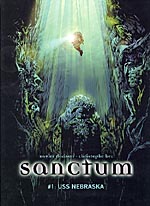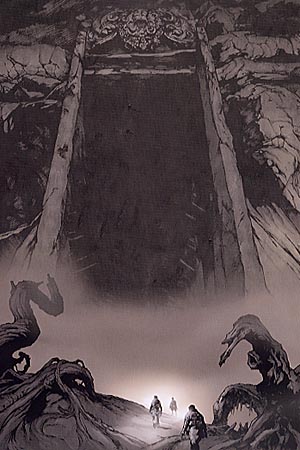 Written by Xavier Dorison
Written by Xavier Dorison
Art by Christophe Bec
64 pages, color
Published by Humanoids Publishing
Oceans are, in many ways, the last great unexplored frontier of this planet. We’re constantly discovering new species existing under the waters, each time with the knowledge that there is still much more to find. Maybe that’s what the initial attraction to Sanctum was; the idea of a massive temple hidden under the water is just too cool. Of course, what you hope for and what you find are two very different things, as the crew of the U.S.S. Nebraska discovered…
In the year 2029, the U.S.S. Nebraska is on a routine mission when a distress call from another submarine sends them off course… whether they like it or not. As plagues and dementias ravage the crew of the sub, its captain and a handful of men must discover why a Russian sub ventured here seventy years earlier, and what the real secret of the hidden sanctum beneath the ocean is.
Having really enjoyed Xavier Dorison’s Ante Genesem (also published by Humanoids), I was expecting a lot more of the same, but got something entirely different. Where Ante Genesem focused almost entirely on a single person, Sanctum has a much larger cast to deal with… almost too large a cast. It’s very difficult to keep track of most of the characters, especially when new ones keep showing up only to die several pages later. It’s a shame, because it really detracts from the story that Dorison is trying to tell; there’s too much extraneous stuff going on to let the ideas shine through. When you step back and look at the first two volumes on a simpler scale, it’s got an interesting enough story; it’s the finer details where the reader gets lost. If a lot of the unnecessary material had been—how many characters do we need to get shuffled on and off the page?—this series could have probably been trimmed down from three to two volumes and kept readers’s attention a lot more easily.
 One can’t help but wonder if part of the fault is with Christophe Bec’s art on Sanctum. It’s odd, because there are aspects that he does a fantastic job with, and others where everything seems to fall apart. When it comes to the big, awe-inspiring moments of Sanctum, Bec’s perfect for the book. The glimpses of the Ugarit temple look fantastic, and you get a real sense of wonder for this new discovery on the part of the U.S.S. Nebraska’s crew. It’s the smaller details, then, that get lost in the shuffle. Dorison’s introducing numerous characters might have been easier to follow if one could tell them apart; despite having a style that goes for realistic-looking faces, they’re somehow harder to differentiate from each other. There are times with the art also doesn’t seem to be following the story—the best being when someone points out their location on a map, only instead of showing the Mediterranean, it’s the South China Sea.
One can’t help but wonder if part of the fault is with Christophe Bec’s art on Sanctum. It’s odd, because there are aspects that he does a fantastic job with, and others where everything seems to fall apart. When it comes to the big, awe-inspiring moments of Sanctum, Bec’s perfect for the book. The glimpses of the Ugarit temple look fantastic, and you get a real sense of wonder for this new discovery on the part of the U.S.S. Nebraska’s crew. It’s the smaller details, then, that get lost in the shuffle. Dorison’s introducing numerous characters might have been easier to follow if one could tell them apart; despite having a style that goes for realistic-looking faces, they’re somehow harder to differentiate from each other. There are times with the art also doesn’t seem to be following the story—the best being when someone points out their location on a map, only instead of showing the Mediterranean, it’s the South China Sea.
The first two volumes of Sanctum are both intriguing and frustrating simultaneously; there’s so much potential here, and you can see both Dorison and Bec struggling to get a really good story to the surface. Like the crew of the U.S.S. Nebraska discovers in Sanctum, though, getting to the surface can be more difficult than it seems. When Sanctum does work, though, like increasing the feel of dread and doom around the submarine, or evoking a sense of wonder… it truly is magical. Here’s hoping for more of those moments in the upcoming final volume.
